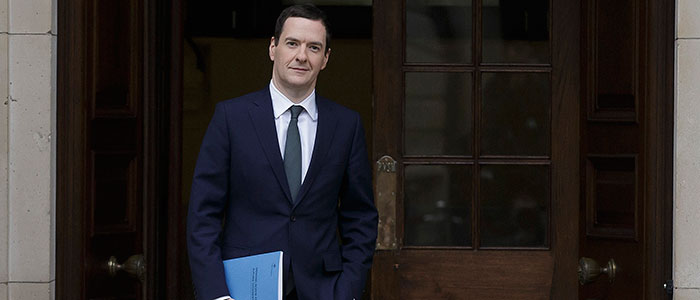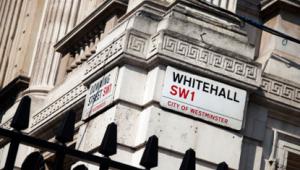
The chancellor had been under pressure over planned tax credit reforms that were set to almost halve the income level at which support is withdrawn from £6,420 to £3,850.
Opponents, including some Conservative MPs, had campaigned for the changes to be introduced more gradually and last month the House of Lords vetoed the reform, which was intended to contribute to the £12bn of welfare savings.
However, delivering his Autumn Statement and Spending Review today, Osborne said improved Office for Budget Responsibility forecasts meant he was able to scrap these plans.
The OBR has set out a £27bn improvement in the public finances compared to the summer Budget, due to both higher tax receipts and lower debt interest, the chancellor told MPs.
“And because I’ve been able to announce today an improvement in the public finances, the simplest thing to do is not to phase these changes in, but to avoid them altogether,” he said.
“Tax credits are being phased out anyway as we introduce Universal Credit. What that means is that the tax credit taper rate and thresholds remain unchanged. The minimum income floor in Universal Credit will rise with the National Living Wage I set a lower welfare cap at the Budget.”
The change means the government would breach its total welfare spending cap, set at £115.2bn until 2019/20, but Osborne said the cap would be met in the latter part of the Parliament.
Overall resource spending by Whitehall departments will fall by 0.8% per year on average in real terms, meaning a cumulative reduction of 19% to 2019/20.
Figures published in the review show that local government grant from DCLG, which Osborne said would be phased out as part of the move towards full local retention of business rates, was the most cut. It will fall by 56% from the 2015/16 baseline to 2019/20.
The biggest Whitehall cut in day-to-day spending is the 37% cut to the budget of the Department for Transport, although the chancellor said that the DfT’s capital budget would rise by half to £61bn, including funding for construction of the High Speed 2 rail link.
DCLG’s communities budget will be cut by 29%, while revenue spending at the Treasury will fall by 24%.
In addition to real-terms protection for the police budget, the chancellor also announced that the housing budget would double over the parliament to more than £2bn a year to help deliver 400,000 affordable new homes by the end of the decade.
The introduction of an apprenticeship levy is expected to raise nearly £3bn by 2019/20, the biggest single tax rise in the Spending Review, while higher stamp duty on buy to let homes will raise £825m by then. Changes to the Renewable Heat Incentive are expected to raise £460m, while improving tax record keeping though digitisation is expected to raise £300m.
Commenting on the announcements, CIPFA chief executive Rob Whiteman said that headline announcements, including no cuts to the police and funding for health and social care, are all welcome signs.
“CIPFA has also called for front loaded funding to the NHS, which was confirmed by the chancellor earlier. Now, it must be made clear exactly what services he expects the extra cash to cover. That list is getting longer,” he added.
“As an overview, the chancellor’s announcement earlier provided many reasons to be cautiously optimistic. But like any similar announcements, the devil will be the detail and, as accountants, we will now be working through the numbers to make sure they add up.”
Ian Stewart, the chief economist at Deloitte, said that the UK growth and outlook for tax receipts had “saved the day”.
He added: “The chancellor appears to have achieved the impossible – easing the squeeze on public spending, dumping cuts to Tax Credits and sticking to his deficit reduction plans.
“Revenue-raising measures, especially the Apprenticeships Levy, have helped, but the game changer is a more optimistic view from the Office of Budget Responsibility on prospects for tax receipts.”
Departmental Programme and Administration Budgets (Resource DEL excluding depreciation) (1)
| £bn | Per cent | ||||||
|---|---|---|---|---|---|---|---|
| Baseline (2) | Plans | Cumulative | |||||
| 2015-16 | 2016-17 | 2017-18 | 2018-19 | 2019-20 | 2020-21 (3) | real growth | |
| Resource DEL excluding depreciation | |||||||
| Defence | 27.2 | 27.8 | 28.5 | 29.2 | 30.0 | 31.0 | +2.3 |
| Single Intelligence Account | 1.8 | 1.8 | 2.0 | 2.1 | 2.2 | 2.3 | +17 |
| Home Office | 10.3 | 10.7 | 10.6 | 10.6 | 10.6 | * | -4.8 |
| Foreign and Commonwealth Office | 1.0 | 1.0 | 1.0 | 1.0 | 1.0 | * | +0.0 |
| International Development | 8.5 | 9.1 | 9.3 | 10.7 | 11.0 | * | +21 |
| Health (inc. NHS) | 111.6 | 115.6 | 118.7 | 121.3 | 124.1 | 128.2 | +3.3 |
| Work and Pensions (4) | 5.8 | 6.1 | 6.3 | 5.9 | 5.4 | * | -14 |
| Education | 53.6 | 54.4 | 55.5 | 56.4 | 57.1 | * | -1.1 |
| Business, Innovation and Skills | 12.9 | 13.4 | 12.3 | 11.7 | 11.5 | * | -17 |
| Transport | 2.6 | 2.0 | 2.1 | 2.2 | 1.8 | * | -37 |
| Energy and Climate Change | 0.9 | 0.9 | 1.0 | 1.0 | 0.9 | * | -16 |
| Culture, Media and Sport | 1.1 | 1.2 | 1.2 | 1.2 | 1.1 | * | -5.1 |
| DCLG Communities | 1.5 | 1.4 | 1.4 | 1.3 | 1.2 | * | -29 |
| Scotland (5) | 25.9 | 26.1 | 26.3 | 26.3 | 26.5 | * | -5.0 |
| Wales (5) | 12.9 | 13.0 | 13.1 | 13.2 | 13.3 | * | -4.5 |
| Northern Ireland (5) | 9.7 | 9.8 | 9.9 | 9.9 | 9.9 | * | -5.0 |
| Justice | 6.2 | 6.5 | 6.3 | 5.8 | 5.6 | * | -15 |
| Law Officers’ Departments | 0.5 | 0.5 | 0.5 | 0.5 | 0.5 | * | -2.1 |
| Environment, Food and Rural Affairs | 1.5 | 1.7 | 1.6 | 1.5 | 1.4 | * | -15 |
| HM Revenue and Customs | 3.3 | 3.5 | 3.4 | 3.1 | 2.9 | * | -18 |
| HM Treasury | 0.2 | 0.2 | 0.2 | 0.1 | 0.1 | * | -24 |
| Cabinet Office | 0.2 | 0.3 | 0.3 | 0.3 | 0.2 | * | +4.4 |
| National Citizen Service (6) | 0.1 | 0.2 | 0.2 | 0.3 | 0.4 | * | – |
| Small and Independent Bodies (7) | 1.5 | 1.5 | 1.5 | 1.5 | 1.5 | * | -6.6 |
| Reserves | 3.5 | 3.5 | 3.4 | 3.5 | 4.1 | * | – |
| Adjustment for non-baselined funding | 0.4 | – | – | – | – | * | – |
| Resource DEL plans (central government) (8) | 304.6 | 312.2 | 316.5 | 320.5 | 324.4 | * | – |
| Local government spending (9) | 40.3 | 38.6 | 38.9 | 39.7 | 40.5 | * | -6.7 |
| - of which DCLG Local Government DEL | 11.5 | 9.6 | 7.4 | 6.1 | 5.4 | * | -56 |
| - of which locally financed expenditure (10) | 28.8 | 29.0 | 31.5 | 33.6 | 35.1 | * | +13 |
| Total Resource DEL excluding depreciation plans | 316.1 | 321.8 | 323.9 | 326.7 | 329.8 | 342.7 | |
| - OBR allowance for shortfall | -1.0 | -1.0 | -1.0 | -1.5 | -1.5 | -1.5 | |
| Resource DEL excluding depreciation | 315.1 | 320.8 | 322.9 | 325.2 | 328.3 | 341.2 | – |
(1) Resource DEL excluding depreciation is the Treasury’s primary control total within resource budgets and the basis on which Spending Review settlements were made.
(2) As at all Spending Reviews baselines exclude one-off and time-limited expenditure. Cumulative real growth is calculated to 2019-20 from the 2015-16 baseline.
(3) 2020-21 departmental budgets have only been set for some departments. For the rest these budgets will be set in full at the next Spending Review.
(4) DWP and HMRC’s settlements reflect the transition of Tax Credits into Universal Credit from HMRC to DWP. The underlying reduction excluding the effect of this transition would be -16% for DWP and -15% for HMRC.
(5) The Government agreed that as part of the £3bn savings in 2015-16 as announced on 4 June 2015 the devolved administrations could defer their cuts to 2016-17. We assume here that all the devolved administrations take their reductions in 2016-17. These settlements are subject to change as the devolved administrations finalise their spending plans.
(6) National Citizen Service is part of Cabinet Office DEL.
(7) A detailed breakdown of small and independent bodies is set out in Table 2.25.
(8) Excludes the central government grants to local authorities through DCLG Local Government DEL but not grants to local authorities from other government departments.
(9) Local government spending is the sum of DCLG Local Government DEL and locally financed expenditure in England (based on the OBR’s forecast of Local Authority Self-financed Expenditure) which includes forecasted growth in council tax and business rates. This does not include the impact of 100% business rate retention which the government will consult on shortly.
(10) Treasury/DCLG analysis based on OBR’s forecast of local authority current expenditure in England (November 2015). This includes OBR assumptions that local authorities add £1.1/£0.8/£0.4/£0bn of income to reserves over the SR period.




















